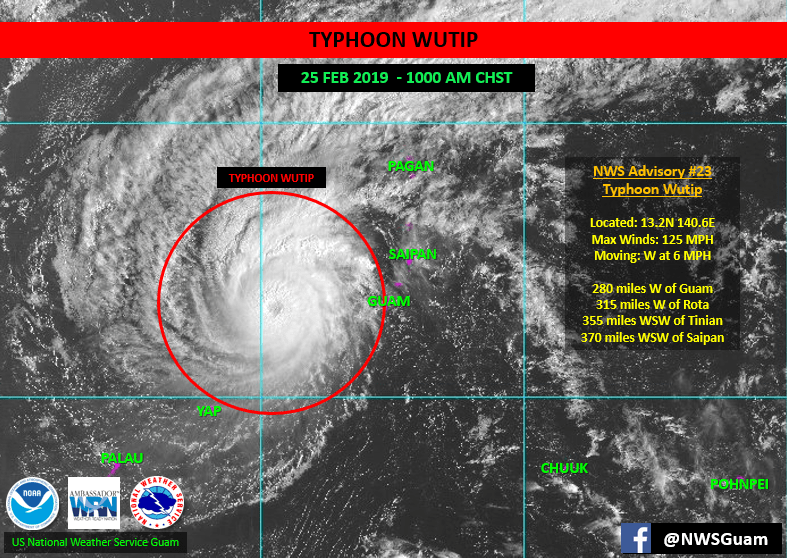The United States suffered an onslaught of destructive weather over the weekend. A tornado killed a woman in Mississippi, a blizzard buried parts of the Great Plains, and flash floods led to water rescues in the South, temporarily halting barge traffic on the Tennessee River. But the U.S. territory of Guam, on the other side of the world in the south Pacific, had a scare of its own, getting sideswiped by a super typhoon.
The intense eye of Super Typhoon Wutip, at its closest to Guam, came within 175 miles of the island around 8:00 a.m. local time on Sunday (5:00 p.m. EST on Saturday). The Category 4-equivalent typhoon packed wind gusts of around 180 mph, peaking at Category 5-equivalent strength early Monday morning, making it the strongest February typhoon on record. It is also the longest-lived February typhoon on record, and the first February Super Typhoon in more than a century.
The Mariana Islands are no strangers to typhoons, but February typhoons are quite unusual. The last one to brush by Guam was Irma in 1953. That one dumped almost eight inches of rain in 24 hours. Mike Middlebrooke, a meteorologist at the National Weather Service (NWS) in Guam, told FreightWaves that Wutip was quite a wet storm, with 4.21 inches of rain at Guam’s Antonio B. Won Pat International Airport on Saturday, setting a rainfall record for the date. Another 1.12 inches fell on Sunday, all of it triggering Flash Flood Warnings.

“There was some flash flooding on the southeastern part of the island,” said Middlebrooke. “Inarajan had some issues and picked up more than a foot.”
An automated sensor in the town of Inarajan recorded 16.9 inches over the weekend, its highest two-day rain total on record, and Middlebrooke also said mud covered some roads for a while. The island dodged a bullet since it was on the fringes of the storm. Despite that, Wutip came a bit too close for comfort, producing tropical storm-force wind gusts of 56 mph at the Guam airport. Middlebrooke stated that some trees and power lines were blown down in a few spots, but he hadn’t heard of any major structural damage.
There is a silver lining – Guam desperately needed the rain. Lack of rainfall in recent weeks has made water planning an issue for the Mariana Islands, including Guam. A statement by the National Weather Service on February 11 spoke of drought, stating residents “should plan for drier conditions over the next several weeks and perhaps months.”
Middlebrooke said, “We were close to the point of having to issue fire weather watches. The rain was probably beneficial.”
Wutip has weakened from a super typhoon back to typhoon status, but continues to trudge across the Pacific. The Joint Typhoon Warning Center estimates that Wutip will continue to slowly weaken throughout the week before possibly reaching the northern Philippines.







